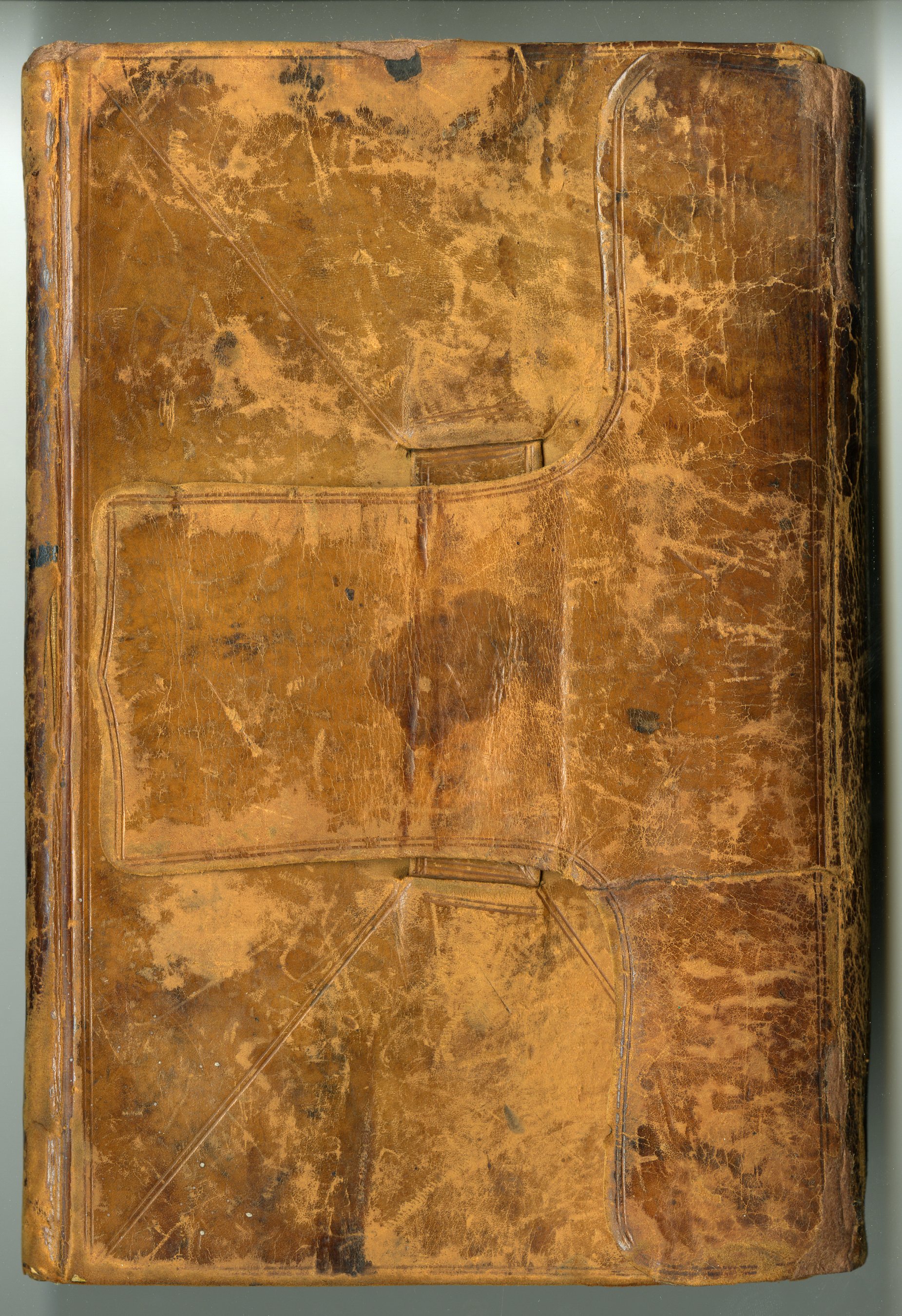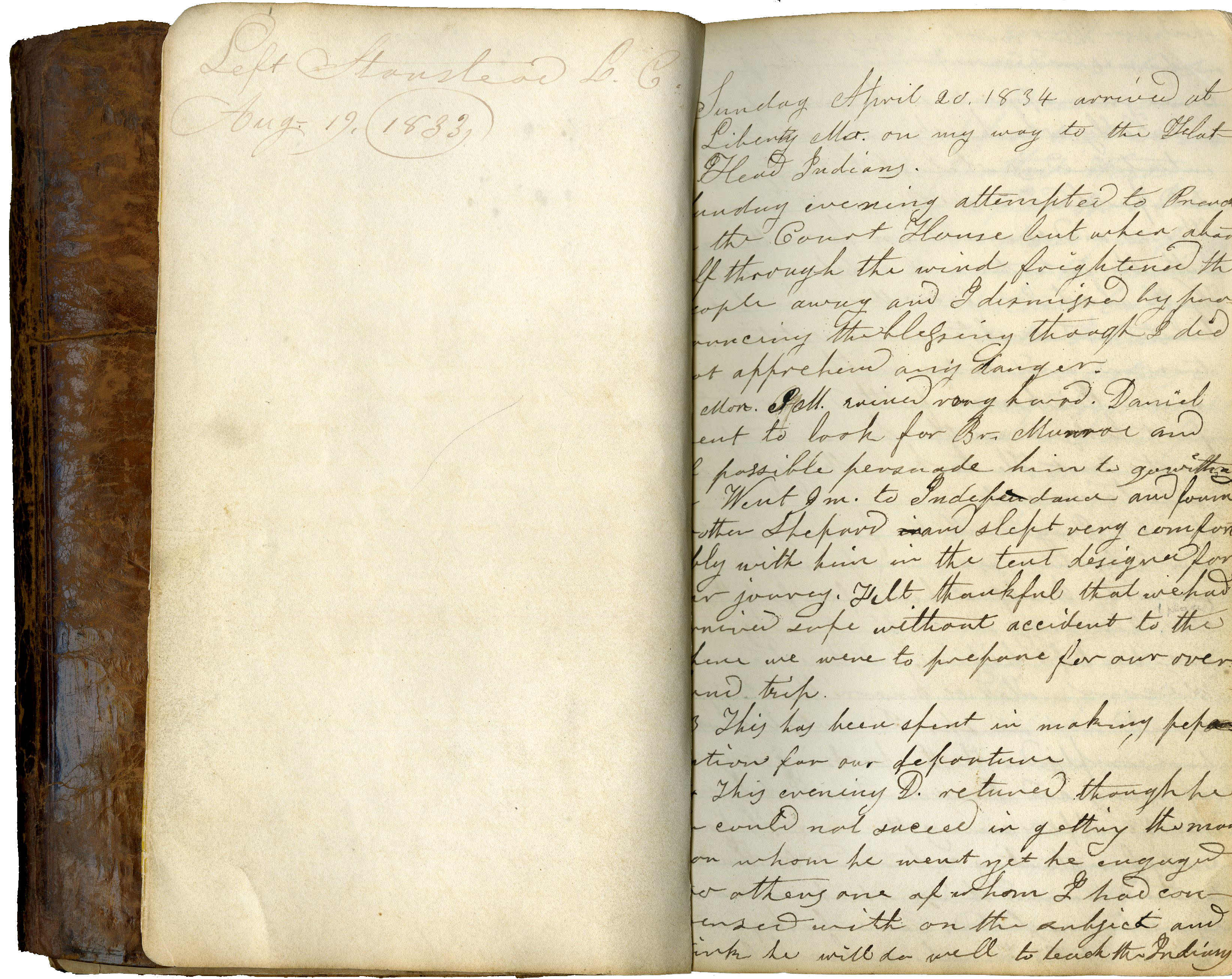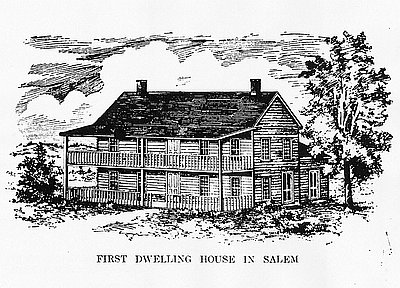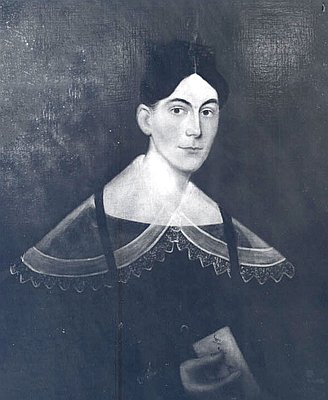This is the diary of Rev. Jason Lee (1803-1845), one of the first Methodist missionaries to travel on the Oregon Trail and settle in Oregon Country. Like all of the missionaries who made the long and perilous journey, Lee was determined to convert the Native people in the region to Christianity. The Methodist Episcopal Church had reason to believe that its missionary efforts would be successful in the West; non-Native fur trappers and explorers, including Captains William Clark and Meriwether Lewis, had reported that Indians had been curious about the power of “the white man’s book of heaven.”
In 1833, Lee was assigned to minister to Native Americans in the Pacific Northwest. Historian Frances Fuller Victor described Lee in The History of Oregon (1886): “tall and powerfully built, slightly stooping, and rather slow and awkward in his movements; of light complexion, thin lips closely shut, prominent nose, and rather massive jaws; eyes of superlative spiritualistic blue; high, retreating forehead, carrying mind within; somewhat long hair pushed back, and giving to the not too stern but positively marked features of a slightly Puritanical aspect; and withal a stomach like that of an ostrich, which could digest anything.”
Lee’s diary begins on August 19, 1833, the day he left for Oregon Country. The final entry is dated June 1, 1838. There is a significant time gap in the middle of the diary, between Sunday, November 9, 1834, and August 18, 1837, when he wrote:
"It is now nearly three years since I have kept any record of the dealings of God with me, or of the events that have transpired around me. Indeed I have written exceedingly little during my life, except what I have been impelled to write by the imperious hand of duty. Hence I have kept no journal except while crossing the Rocky Mountains. And, indeed, such is my aversion to writing that when my time is chiefly occupied in worldly business, and in manual labour (as has been the case the three past years) it is even a burden to sit down to write a letter on business, or answer one of a friend."
Lee's journey to the West began in Canada. Born in Stanshead, Quebec, in 1803, he attended the Wilbraham Academy (Massachusetts) in 1829. He taught at the academy in 1830-1831 and became a traveling preacher in the region in 1832. In 1833, he accepted the call to Oregon Country. Following a fundraising tour of the East Coast, Lee and his traveling companions, including his nephew Daniel Lee, left Missouri in April 1834 in a group led by Capt. Nathaniel Wyeth. Lee’s diary details the long trip, including the obstacles the travelers faced and the people they met.
At times, Lee described the emotional toll of the journey. On August 19, 1834, he wrote: “I turned my back upon them [friends and family in the East] and hurried me away and for what? For riches for honour for ease for pleasure for power for fame in fine was it for anything the world calls good and great? O Thou searcher of hearts Thou knowest. One year is elapsed and I have not yet reached the field of my labours.”
A few days later on August 22 he wrote: “The monotony of this journey is indeed wearisome to mind and body. For some days we have been almost constantly surrounded with mountains...They would appear very beautiful to one who had never before seen the like. But to us who have seen nothing but mountains so long with scarcely a valley intervening there is little to excite interest. Their form is so similar that we almost fancy we have seen them before."
Lee's party arrived at the Columbia River five months later and stepped ashore at Fort Vancouver on September 15, 1834. Dr. John McLoughlin met the members of the Wyeth company when they arrived at Fort Vancouver and, by his own account, guided Lee up the Willamette River to show him the site the chief factor had handpicked for the mission—an area along the southern edge of French Prairie, about ten miles northwest of present-day Salem. Lee’s diary indicates that he was apprehensive about ministering to the Indians in the north, who were reportedly combative, and so was ready to accept McLoughlin’s suggestion of a more southerly location.
By November, Jason and Daniel Lee had built a mission house. The mission was one of few non-Native settlements in the valley, and Lee struggled with loneliness, illness, and frustration with his mostly failed attempts to convert the Indians. Still, he extended the mission and built a school for Native children in 1835. Of the more than forty students who attended during the first two years, over half became ill or ran away.
It was during this difficult period that Lee began to rethink his role in the resettlement of the West. He became convinced that a stable, non-Native community in the Willamette Valley would best facilitate the interests of the Methodist Church. In a March 1836 letter to his friend Dr. Fisk in Montreal, Lee wrote: “That the Indians are a scattered, periled, and deserted race, I am more and more convinced; for it does seem, that unless the God of heaven undertake their cause, they must perish from the face of the Earth, and their name be blotted out from under heaven. God grant that a remnant may be saved, as trophies of the Gospel of Christ, and for a seed to serve him.” He asked for “help from home, (I do not speak of money, but of men and women).”
The members of what became known as the First Reinforcement—a response to Lee’s request to the Methodist Mission Board for more support—arrived at the mission in May 1837, among them married couples and single women. The board sent Anna Marie Pittman as a wife for Jason Lee, and they were married that summer. A Second Reinforcement of about a dozen people arrived in September of that year.
Over time, the mission expanded with a mill (now Mill Creek) and a reinvigorated school, renamed the Indian Manual Training School. The Willamette River flooded the original mission site in 1841, prompting a move to nearby Chemeketa. In 1842, Lee helped form the Oregon Institute, a school for the children of non-Native settlers, that later became Willamette University, in 1842. He also had a chapel built, which became Salem’s First United Methodist Church.
The promise of a mission community—peopled with Lee’s peers and organized around familiar cultural structures—reenergized Lee, and in the following years he became an advocate for the American resettlement of Oregon Country. He helped form the Willamette Cattle Company in order to break the monopoly the Hudson’s Bay Company had over the cattle market in the region, advocated for land grant legislation to encourage white settlement, and helped form the Oregon Temperance Society. He co-authored a memorial calling for Congress to take possession of Oregon, and delivered the document to Washington, D.C. in 1839. An early proponent of territorial government, Lee chaired an 1841 meeting in Champoeg of white male settlers interested in forming a provisional government.
Lee traveled to the East twice after settling in Oregon Country. His first trip in 1838 was to request support from the Methodist Mission Society and to advocate for the resettlement of Oregon. He took with him two Indian boys who had converted to Christianity to demonstrate his success (one died on the trip), and he toured the eastern states promoting the benefits of western settlement. He persuaded the Mission Society to send more money and people to Oregon, and returned home by ship with about fifty new emigrants in 1840. This emigration became known as the Great Reinforcement. In his absence, his wife Anna had died in childbirth. While in New York, he met and married Lucy Thompson, who returned with him to the Willamette Valley.
Lee made a second trip east in 1843, after he received some unwelcome news. His advocacy for the American resettlement of Oregon was at odds with the goals of the Methodist Mission Board—to minster to, educate, and convert Native populations—and he was being replaced as head of the Willamette Mission by Rev. George Gary. Lee had helped build a thriving American community in the Willamette Valley, but his school for Indian children had declined as the Indian population grew smaller—a result of disease, resettlement, land use, and violence. Lee returned to New York to defend himself of charges of mismanaged funds and land speculation.
Lee successfully defended himself at his hearing, and his title as Missionary to Oregon was reinstated; but he became ill and returned to Stanshead to convalesce with relatives. He died there in 1845, at the age of forty-one. The mission was later memorialized as the Jason Lee House, and he was reinterred in 1906 in the Lee Mission Cemetery in Salem. His statue stands in Willamette University, the state capitol grounds, and in Statuary Hall in Washington, D.C.
Written by A.E. Platt, 2016
Further Reading
The Papers of Jason Lee. Oregon Historical Society, Portland, Mss 1212.
Brosnan, Cornelius. Jason Lee: Prophet of the New Oregon. Rutland, VT.: Academy Books, 1985.
Dye, Eva Emery. McLoughlin and Old Oregon: A Chronicle. Cambridge, Mass.: University Press, 1900.
Memorial Souvenir, Jason Lee. Compilation of addresses delivered at the reinternment of Jason Lee in Salem, Oregon, June 15, 1906.



